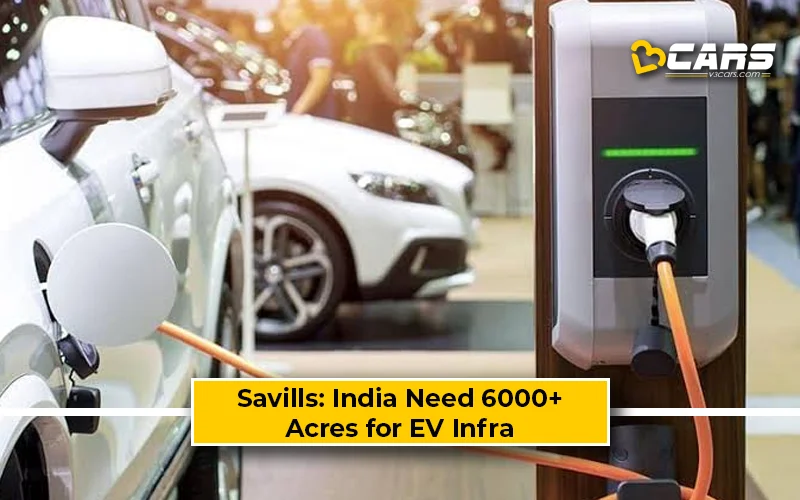India Need 6000+ Acres For EV Infra By 2030: Savills (Press Release) | V3Cars
Savills India estimate that India will require over 6,000 acres of land and up to USD 9 billion in investment to develop EV manufacturing, battery plants, and charging infrastructure by 2030.

Also Read: 2025 Hyundai Alcazar Corporate Launched – Diesel Variant Finally Gets Panoramic Sunroof
Note: Buy Used Car Online in Delhi NCR – Explore second-hand cars with verified listings
Here’s what Savills India have to say about the report launch:
To mark the occasion of World Environment Day, Savills India, a leading global real estate advisory firm, today released a comprehensive report titled Charged for Change: How EVs Are Reshaping Indian Real Estate, highlighting that India will require 5,760 to 6,852 acres of land by 2030 to support EV manufacturing, lithium-ion battery plants, and public charging infrastructure. According to Savills India, the EV market in India has witnessed significant growth in recent years, driven by market forces, government policies, rising environmental concerns, and increasing fuel costs – factors encouraging individuals and businesses to adopt cleaner alternatives. The Government of India has launched several initiatives to accelerate EV adoption and strengthen the supporting ecosystem.
Rising domestic manufacturing, with the entry of key players, is reducing import dependency and improving cost competitiveness. Technological advancements in battery efficiency, driving range, and charging capabilities are making EVs increasingly practical. Additionally, the availability of a skilled workforce is fueling R&D and domestic manufacturing, further boosting demand and fostering a robust ecosystem for sustained EV growth in India.
Aligning with India’s target of achieving 30% EV penetration by 2030, the real estate sector is expected to experience significant growth driven by the rise in EV adoption. The growing demand for EVs will stimulate the need for multiple real estate segments, including industrial and warehousing spaces to support EV and battery manufacturing, EV assembly units, and the storage and distribution of EV components and batteries. Additionally, the expansion of supply chains will increase the demand for strategically located warehouses and logistics parks. The government’s role with several policies and various initiatives, collectively aims to establish a robust EV ecosystem in the country by fostering innovation, investment and infrastructure development while addressing climate change and energy security concerns.- Srinivas N, Managing Director, Industrial & logistics, Savilla India.
EVs Sales Forecast and Real Estate Opportunity in EV Manufacturing
The Ministry of Road Transport and Highways (MoRTH), in line with projections by NITI Aayog and the Rocky Mountain Institute (RMI), estimates cumulative EV sales in India to reach 25.3 to 31.8 million units by 2030 – an annual average of 4.2 to 5.3 million units. According to Savills India Research, this will drive land requirement of 2,009 to 2,467 acres for manufacturing facilities, with a built-up potential of 43.8 to 53.7 mn sq. ft.
Note: RE investments refer to investments in land and the construction of facilities required for the manufacturing of EVs.
Need for Public Charging Infrastructure and Real Estate Opportunity
To accommodate this substantial increase in EV adoption, Savills India Research estimates that India will need 81,000 to 92,500 public and semi-public charging stations, maintaining a 1:20 station-to-vehicle ratio. This translates to a total land requirement of 2,402 to 2,744 acres, with a built-up potential of 52.3 to 59.8 mn sq. ft. requiring an investment of USD 2.8 to 3.2 bn. Significant infrastructure will also be needed for electric two-wheeler charging across office complexes, malls, transit hubs and public parking areas.
|
|
|
|
|
|
|
|
|
|
|
|
|
|
|
|
|
|
Note: RE investments refer to investments in land and the construction of public charging stations.
Li-Ion Battery Demand Forecasts and Real Estate Opportunity
India aims to produce 13% of its EV battery cell demand domestically by 2030, reducing reliance on imports from countries like China, South Korea, and Japan. Lithium-ion battery manufacturing capacity, currently at 4 GWh (as of 2023) is projected to rise to between 147 GWh and 179 GWh by 2030, according to Savills India Research. This will require a total land requirement of 1,348 to 1,641 acres of land with a built-up potential of 29.3 to 35.7 mn sq. ft. and an investment of USD 1.9 to 2.3 bn for land and construction.
|
|
|
|
|
|
|
|
|
|
|
|
|
|
|
|
|
|
|
|
|
Note: RE investments refer to investments in land and the construction of facilities required for the manufacturing of lithium-ion batteries.
Overall Real Estate Opportunity by 2030
Savills India anticipates strong demand for large land parcels for EV battery, and component manufacturing, and smaller plots for charging stations across cities. By 2030, India will need approximately 5,760 to 6,852 acres with a built-up potential of 125 to 149 mn sq. ft., translating to 21 to 25 mn sq. ft. annually. This will require a real estate investment of USD 7.5 to 9.0 bn, mainly for land and facility development.
|
|
|
|
|
|
|
|
|
|
|
|
|
|
|
|
Note: RE investments refer to investments in land and the construction of facilities required for the manufacturing of EVs and lithium-ion batteries, and for the setting up of public charging stations.
Also Read: Hyundai CEO José Muñoz Reinforces Mobility Vision At FISITA (Press Release)
Note: Check Petrol, Diesel & CNG Prices in India – Stay updated with Petrol Prices, Diesel Prices and CNG Prices
Mileage Calculator – Easily calculate your car or bike’s average using fuel filled and distance covered


0 Comments